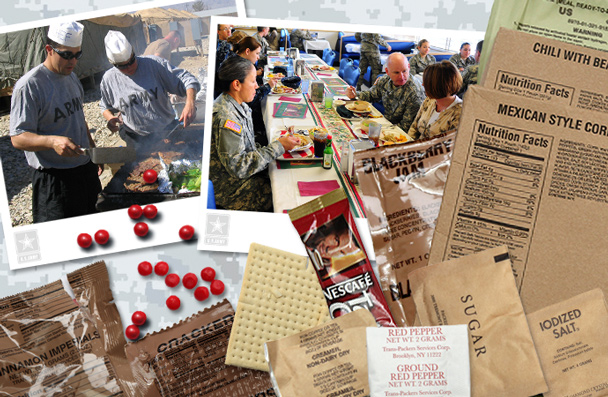Early this year, the U.S. Department of Defense announced an overhaul of its food service for members of the military. The Military Health System initiative, the first of its kind in more than 20 years, has so far met with approval from First Lady Michelle Obama, a champion of healthy eating through her Let's Move campaign and other efforts, as well as the men and women on the first line of defense. A Defense Department spokeswoman described the strategy: "We're working to align Service efforts to update menu standards, make healthier foods available in Service member dining facilities, and address obesity as a health and readiness issue across our Military Health System."
At first glance, the initiative seems simple, almost modest, in its goals: Serve more fresh foods on base. Post nutritional information about what's on offer. Help soldiers make informed food decisions. Provide more fruits and vegetables. It makes you wonder what, exactly, we were feeding our armed forces before this program was implemented.
The Department of Defense, through its Logistics Agency, oversees a huge food service program: It spends $4.65 billion annually to feed 1.45 million uniformed service members, civilians in service, and contractors. Its food service operations span the globe and range from thousand-seat dining facilities in Afghanistan to lowly vending machines on bases far from combat. It stands to reason that change might come slowly to a vast, complex, and expensive system.
We asked current and former members of the service in every division from the Marines to the Air Force to the Army Corps of Engineers to share their impressions of military meals, both on base and in the field, whether recent or long-remembered. All of them agreed that almost anything tastes good when you're far from home or under fire, and that given the obvious logistical complications of providing fuel to soldiers around the world, none of them were inclined to complain about the chow. "Sacrifice—particularly in the form of food options—is an expected part of military life," points out Lisa Horgan, who served as a biomedical engineer with the 48th Fighter Wing of the Air Force and was based in Lakenheath, England, from 1996 to 2000.
Necessary evils, aside, though, most of the servicemen and women we heard from had vivid memories of some, shall we say, not-so-necessary evils, such as the infamous MREs (meals, ready to eat) that more than one soldier recalls had the power to turn stomachs. And most servicepeople we spoke with reflected that their time in the military has had lasting effects on their palates. "To this day, I put hot sauce on just about everything I eat because of my time in the Marine Corps," acknowledges Jonathan B. Connors, an officer in the Marines in the early 1990s. Horgan agrees that she acquired a taste for spicy seasonings while eating in the military: "I always ask friends to pick up local spices for me when traveling. We've just received an amazing paprika from Hungary and a home-made dry rub from Texas." Likewise, my own father, an otherwise-excellent cook who did two tours in Vietnam as a Marine, never met a dish he wouldn't put Tabasco or cayenne pepper on—including French toast.
Daniel Gorman, an active National Guardsman and Iraq veteran who has served a total of 15 years in the Navy and the National Guard, suggests that the relationship between our soldiers and what they eat goes deep, and for good reason: "I think soldiers definitely gain an affinity for good food, particularly those that have been deployed or served in austere environments. It's almost as though given everything that is out of your control in those situations, food becomes one of the small things you can control in a certain way. Even the MRE comes with directions on how to eat it, but everyone has their way."



 Pinterest
Pinterest


